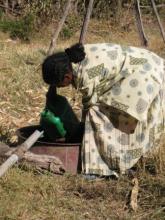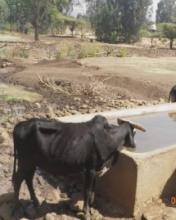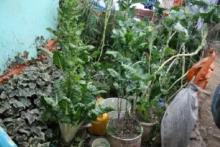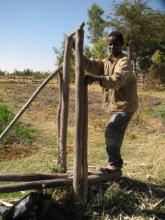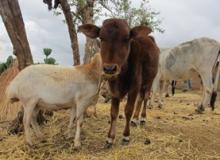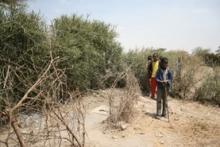Document
This document reports on the 'IWRM Demonstration Project: Improved livelihoods in lower Limpopo' carried out in Ndonga community, Mozambique. The project aimed to demonstrate how principles of IWRM can be put into practice in poor rural areas. The focus was on those principles that have received limited attention as yet: water resource management at the lowest appropriate levels, users’ participation, and the inclusion of women.
In short, the starting point for local-level IWRM is the recognition that people have multiple domestic and productive water needs, certainly in rural areas where agriculture-based diversified livelihoods depend in many ways upon water. Better access to water brings health and alleviates women’s and girls’ burdens of water fetching and it improves production of crops, vegetables, animals and fisheries for food and income.
This article, published in Water Alternatives, examines community-driven multiple use water services (MUS) as pioneered by the Rural Village Water Resources Management Project (RVWRMP) in the Far and Mid-Western development regions of Nepal. These regions are characterised by poverty, remoteness, rugged terrain, food insecurity, water scarcity, and post-conflict legacy. Water provision for domestic and productive uses provides opportunities to address poverty and livelihoods in environments with highly decentralised governance.
This study explores the first-hand lessons learned in the RVWRMP in Nepal since 2006. This project is embedded within the local government. Key project entry points are decentralisation, participation and empowerment. This article reflects how the community-managed systems are used for multiple uses whether they were designed for it or not. It focuses on household- and community-level changes and related institution building and participatory planning through Water Use Master Plans and a Step-by-Step approach. Recommendations are made for scaling up multiple use services.
Sanna-Leena Rautanen, Barbara van Koppen, Narayan Wagle, 2014
Community-driven multiple use water services: Lessons learned by the Rural Village Water Resources Management Project in Nepal, Water Alternatives 7(1): 160-177
This document, developed by the FAO, presents the conceptual and practical approaches proposed for auditing multiple services in large irrigation systems. It is called MASSMUS, which stands for Mapping System and Services for Multiple Uses of Water Services.
It is a step-by-step progressive process that starts with a rapid appraisal procedure (RAP), then proceeds with further steps related to capacity, water balance, cost and development of a vision, and the design of interventions to modernize the management set up and operation techniques. Some adaptation to the specific function and constraints, inputs and outputs for MUS has been made where necessary.
An important aspect of the MASSMUS approach for auditing water services to irrigation systems is the reference for benefits, which is associated to each type of service. Generally references for irrigated agriculture are clear and reliable: yields and water entering the command area (CA) and water used by crops during evapotranspiration are reasonably well known. The benefits of irrigation are often taken to be the monetary value of the total yield throughout the CA.
Calculation example for water needs as used in the Kenya Arid Lands project.
Family wells are privately-owned, although generally shared freely with neighbours for domestic use. Traditional hand-dug wells come in a variety of shapes and sizes according to local geology, material availability and know-how. They can be upgraded by stepwise improvements in lining, well head protection and lifting devices.
In the case study Self-supply family wells for Multiple Use water Services the author concludes that with the right support, many existing family wells could be upgraded to provide supplies that are better for productive and domestic uses (especially more quantity) and drinking (better quality). This support should keep ownership at the household and improve the convenience, safety (both in terms of water quality and collapsing) and potential benefits of the well. Increased availability of water thus enhances the potential for multiple uses. This potential is high, as the more water systems are owned on private basis, the greater the opportunity to use them for multiple purposes.
The case study is part of the MUStRAIN case study series in which the uptake of Multiple Use Services (MUS) in different contexts within Ethiopia is being documented. The case studies analyse cost-benefit relations as well as opportunities and challenges for implementation of MUS.
The Community Managed Project approach (CMP) gives facility users the mandate to plan and manage the implementation of facilities. Water committees manage the facility construction from beginning to end, so there is no handover of the facilities after completion, unlike projects managed by local authorities or NGOs.
The design of these facilities is mainly focused towards domestic water supply, but when the water source is sufficient (usually with springs and not with hand dug wells), cattle watering facilities are common additional components in the design. As the CMP approach builds capacity and successfully engages the private sectors and user communities from the onset, it offers opportunities for end users to pinpoint their needs to be incorporated in the design. Hence, the CMP approach can be used to introduce and promote multiple use water services from project initiation through planning and implementation to the operation and maintenance phase. This has potential, albeit practice is limited to date, enabling users to maximize their benefits from the proposed WASH facilities.
Read this case study to learn more from the current practices, technical constraints and opportunities for scaling up.
The case study is part of the MUStRAIN case study series in which the uptake of Multiple Use Services (MUS) in different contexts within Ethiopia is being documented.
Having a vegetable gardens at the homestead can help improve nutrition, while surplus may be an important source of income. Greywater is a valuable source of water in (semi) arid areas and helps reduce pollution of the compound.
The case study Greywater reuse interventions: keyhole and vertical gardens compares two practices of household gardening in which vegetables are watered using greywater (household wastewater from kitchen and washing).
- A keyhole garden is a waist height garden bed surrounded by rocks and stones, with a walkway (‘keyhole’) to allow easy access. The bed is comprised of layers of various organic materials that add nutrients and retain moisture.
- A vertical garden is made from a bag or other vessel, filled with a mixture of soil, ash and compost. Leafy greens are cultivated in holes, cut in the side of the bag, and on top. Some designs include a gravel column at the centre of the bag to allow filtration of greywater.
The case study is part of the MUStRAIN case study series in which the uptake of Multiple Use Services (MUS) in different contexts within Ethiopia is being documented. The case studies analyse cost-benefit relations as well as opportunities and challenges for implementation of MUS.
The case study Manual well drilling: an alternative for shallow groundwater development for multiple use services (MUS) looks into the features of manual well drilling in Ethiopia and the costs and benefits. Manual drilling is a fast and relatively low-cost method of accessing shallow groundwater for multiple uses.
There is a large variation in cost between the enterprise or organisations involved, and diameter. Manual drilling is normally cheaper than hand digging. Reasons are due to time taken and the lower cost of lining.
Initially, promotion and distribution of manually drilled wells was set up for irrigation, but in practice people use these wells for various purposes, as they are convenient. The smaller diameter well and its covering slab prevent inflow from dirty surface water.
The case study is part of the MUStRAIN case study series in which the uptake of Multiple Use Services (MUS) in different contexts within Ethiopia is being documented. The case studies analyse cost-benefit relations as well as opportunities and challenges for implementation of MUS.
Livestock watering is one of the most widespread productive uses of water in multi-purpose water supply systems in Ethiopia. At the same time, livestock may increase degradation of grazing lands threatening water resources.
The impacts of improved water supply on livestock productivity may be high, and combined with watershed management measures that restrict free grazing, livestock management practices may be strongly affected.
The case study is part of the MUStRAIN case study series in which the uptake of Multiple Use Services (MUS) in different contexts within Ethiopia is being documented. The case studies analyse cost-benefit relations as well as opportunities and challenges for implementation of MUS.
This case study focuses on the less documented faecal sludge reuse interventions in Ethiopia: Arborloo and Fossa Alterna, as implemented in East Arsi and Eastern Hararghe, in the Central Rift Valley, and in Arba Minch.
The case study is part of the MUStRAIN case study series in which the uptake of Multiple Use Services (MUS) in different contexts within Ethiopia is being documented. The case studies analyse cost-benefit relations as well as opportunities and challenges for implementation of MUS.


